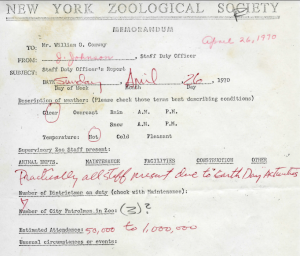In early 1970, the United States’ new environmentalist movement conceived of the first-ever Earth Day, a day of action and awareness. New York City celebrated with an all-day rally at Union Square Park. Exhibitors at Union Square included groups focused on air, water, and noise pollution; urban public health issues such as pest control and lead poisoning; the conservation of wildlife and wild places; nuclear power, peace, and disarmament; population and food issues; and several other environmental and civic causes. (List of exhibitors , April 1970. William G. Conway records, circa 1900-2004 (bulk 1960-2003). Collection 1028.)
The New York Zoological Society [NYZS] was one of the exhibitors at Union Square, and it also held additional events at the Bronx Zoo. To mark the occasion NYZS produced educational materials, special curricula, and a brochure on endangered species entitled ‘What’s a Tiger, Daddy?’. Signage requested by the Education Department was to warn of the calamitous effects of DDT (this was before effective bans were in place), allude to habitat destruction that would be caused by the proposed Miami Everglades Jetport, and predict that if the population trends of the 1970s continued the world’s population of 3.7 billion people would double by 2005. (Memo from Jim Waddick to Jerry Johnson. April 12, 1970. William G. Conway records, circa 1900-2004 (bulk 1960-2003). Collection 1028.) Estimates vary, but it is generally accepted that the world’s population reached 7 billion in late 2011 or early 2012.
These signs may or may not have been produced, for the Exhibits and Graphic Design department was busy with the Zoo’s main event, the first ‘graveyard’ of extinct animals, which featured tombstones for over 200 species and subspecies that humanity had driven to destruction since 1600. As noted in NYZS’s press release for Earth Day, the Bronx Zoo scheduled numerous other events for the week, and by all accounts the Sunday that culminated the affair saw one of the largest crowds the Zoo has ever hosted.

Detail from Jerry Johnson’s Staff Duty Officer Report for Sunday, April 26, 1970. William G. Conway records, circa 1900-2004 (bulk 1960-2003). Collection 1028.
The New York Aquarium also sponsored a booth at Union Square, celebrating the recent discovery of the songs of the great whales by NYZS field scientists. The booth promoted the upcoming release of an LP of the whale song recordings and raised money for the Aquarium’s Whale Fund, which funded the Society’s anti-whaling campaigns. (Correspondence between William G. Conway, Nixon Griffis, and Ross F. Nigrelli, April 1970. New York Aquarium records, 1903-1998 (bulk 1960-1990). Collection 3001.)
The day after Earth Day the Aquarium presented an all-day teach-in, with lectures on whales, whale songs, and water consumption; audiovisual programs on water pollution, beach erosion, and the disappearance of wetlands; and a special, carefully monitored, hands-on exhibition of endangered sea turtles. Meanwhile staff of the Aquarium’s Osborn Laboratories of Marine Sciences gave lectures and participated in symposia at local schools and universities.
In the decades since those first teach-ins and rallies, the New York Zoological Society, now the Wildlife Conservation Society [WCS], has continued to celebrate the Earth’s fragile ecological heritage. The Bronx Zoo’s annual members’ clean-up day has often been held in the third or fourth week of April, and starting with the Central Park Zoo’s celebration of Earth Day’s 20th anniversary in 1990, WCS’s other zoos have held festivities as well. For the 1990 Central Park Zoo celebration, docents staffed several Conservation Stations. Each station featured a topic specific to its site at the Zoo, for example deforestation for the Tropic Zone station, the dangers marine life faced from plastic trash at the sea lion pool, and household water consumption at the pond area.

Preliminary sketch of the proposed stations for the Tropic Zone and for the Panda Pavilion. Proposal memo from Denise McClean, Ann Squire, and Alison Power to Richard Lattis, February 22nd 1990. Wildlife Conservation Society. City Zoos Director Richard L. Lattis records, 1964-2003. Collection 3010.
This year there are–once again–events taking place at Union Square. Meanwhile WCS is observing the festivities with a family ‘Earth Day at the Zoo’ at the Central Park Zoo, a celebration for Girl Scouts at the Prospect Park Zoo, and the 6th Annual Run for the Wild at the Bronx Zoo on Saturday April 26th.
—
As an aside, the Wildlife Conservation Society Archives would like to note that while April 22nd marks Earth Day, April 23rd is Administrative Professionals’ Day. We applaud office managers, secretaries, executive assistants, and other admins for all the care and effort they put in to their jobs.
Archivists have a specific appreciation for that work, as we see that admins can have as much of an impact on the collections that come to exist in our holdings as do the creators of the records themselves. This holds especially true for much of our 20th Century correspondence, as these professionals committed documents to paper by taking dictation, ensured the records existed in both the senders’ and recipients’ collections by making file copies and mailing the originals, and created logical context for the documents by creating filing systems and attaching responses to the letters to which they replied.
The collections I’ve processed over the past couple of years would be far poorer representations of the work of the Society without the intervention of the administrative professionals who maintained them before they were sent to the Archives. These admins–for example Louise Ingenito and Gail Bonsignore at the Bronx Zoo, and Gerry Marsteller and Myra Schomberg at the New York Aquarium–have all my thanks.

